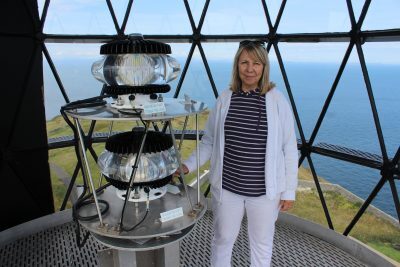Marilyn Turk's Blog, page 2
October 16, 2024
Featured Author at Louisiana Library Book Festival
If you’re anywhere near Baton Rouge, Louisiana on November 2, 2024, come see me!
I’ll be on an author’s panel discussing Women and War: Inspirational Fiction, from 9:00- 9:45 in the Louisiana State Capitol, Room 2.
Then I’ll be signing books in the Book Tent from 10:00-10:45.
See you there!
https://louisianabookfestival.org/fea...
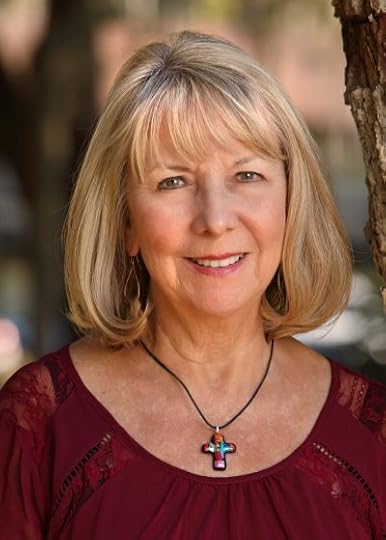
Marilyn’s picture, 2022
The post Featured Author at Louisiana Library Book Festival appeared first on Pathways of the Heart.
Book signing
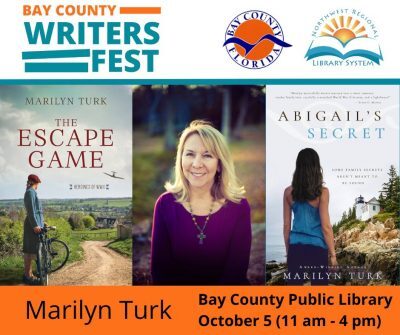
Bay county writers fest
On October 5, I was a featured guest at the Bay County Library Fest. What a delight!
The post Book signing appeared first on Pathways of the Heart.
September 26, 2024
A Visit to Turnberry Lighthouse

Turnberry Lighthouse, Scotland
This summer, my husband and I were able to check a box on our bucket list and travel to the United Kingdom. One of the highlights of our trip was being able to see lighthouses in Scotland. Like in the United States, these lighthouse properties are managed or owned by different entities. Some are private homes, and some are small hotels, so access to them is closed or minimal.
But if the lighthouse itself is still operating as an active aid to navigation, it is managed by the Northern Lighthouse Board in Edinburgh, Scotland.
Unlike the United States, the lighthouses in Scotland have similar appearances, white stucco with gold trim and a white stucco wall around the property. And the settings were fabulous. The lighthouses we saw were set on cliffs facing the Irish Sea. But despite the similarities, each had distinctive characteristics as well.
The first lighthouse we visited was Turnberry Lighthouse which happens to be set between the 9th and 10th holes of the Turnberry Golf Club. Of course, the lighthouse designed by David and Thomas Stevenson built in 1873, was there before the golf course. But way back before that, it was the location of the castle of Robert the Bruce, the king of Scotland in the 1300’s. And in World War II, it was the site of a Royal Air Force landing strip.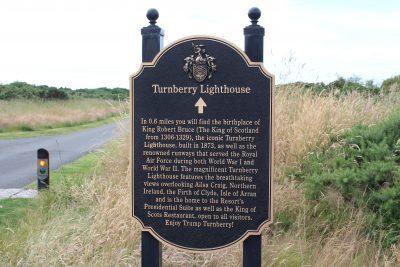
In 2014, Donald Trump bought the golf course and began a massive renovation. When he heard the Turnberry Lighthouse was also for sale, he bought it too and renovated it, so that now there is a snack bar for golfers at its base and also offers a luxurious two-bedroom suite for overnight guests. However, the light which is managed by the Northern Lighthouse Board, is still an active aid to navigation with a light that shines 28 miles out to sea.
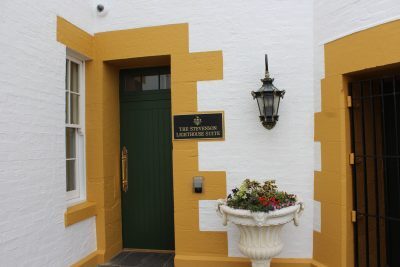
Turnberry guest suite
Isn’t it interesting that with all the changes that have taken place in and around the lighthouse, it still serves the original purpose for which it was built? To shine its light.
In the same way, let your light shine before others, that they may see your good deeds and glorify your Father in heaven. Matthew 5:16
The post A Visit to Turnberry Lighthouse appeared first on Pathways of the Heart.
August 8, 2024
A Visit to Some Scottish Lighthouses

Mull of Galloway Lighthouse, Scotland
When visiting the United Kingdom, my husband and I rented a car to see lighthouses in Scotland. Like in the United States, these lighthouses are governed by different entities, so access is varied.
The light apparatus of those that are still active aids to navigation are managed by the Northern Lighthouse Board in Edinburgh, Scotland.
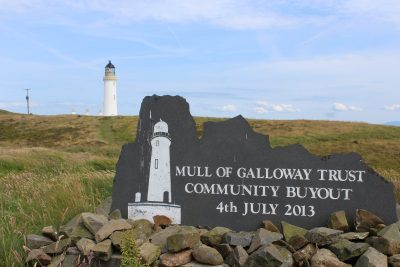 The lighthouses we visited all had similar appearances, white with gold trim, and a white stucco wall around the property, so it can be difficult to tell them apart by pictures. However, each one had other characteristics which distinguished them from the others.
The lighthouses we visited all had similar appearances, white with gold trim, and a white stucco wall around the property, so it can be difficult to tell them apart by pictures. However, each one had other characteristics which distinguished them from the others.
We visited Corsewall Lighthouse which is now a hotel with restaurant. We then went to Killantringan Lighthouse which is privately owned and not an active aid to navigation, so we could only walk around the outside of the property. We also visited Turnberry Lighthouse, which sits by the ninth hole of the Turnberry Golf Club. This lighthouse has a few suites for rent and a small snack bar (mostly for golfers). A fascinating fact about this lighthouse is that it is built beside the ruins of Robert the Bruce’s castle, some of the stone walls still visible.
The last lighthouse we went to was the Mull of Galloway. Although three of the four lighthouses are still active aids to navigation, only the Mull of Galloway allowed people to climb the tower. For that accomplishment, we were awarded a certificate!
Owned by the local community, the Mull of Galloway lighthouse is the most tourist-friendly lighthouse we visited. The lighthouse building had a museum with a docent, as well as a very knowledgeable docent at the top of the tower. In addition, the Gallie Craig Coffee House and gift shop is a short distance down the hill from the lighthouse.
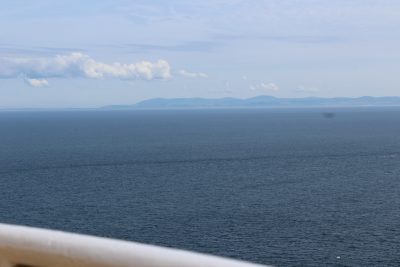
View of the Isle of Man from the lighthouse
The Mull of Galloway, built by engineer Robert Stevenson (grandfather of author Robert Louis Stevenson) in 1830, is the southernmost lighthouse in Scotland. Mull means top or highest point, making its setting on a cliff overlooking the Irish Sea absolutely breathtaking. After climbing 115 steps, you can easily stand in the large lantern room which originally housed a huge lighting apparatus but now uses smaller and more updated optic lights. From the lantern room and the balcony outside, you can see the Isle of Man and also Ireland, some forty miles away.
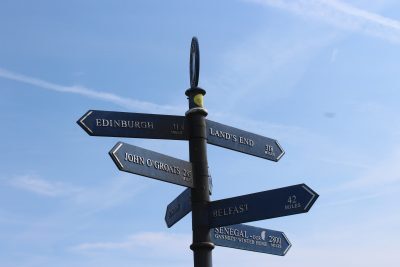
Where am I ?
Adding to the beauty of the setting is the natural wildlife reserve which is home to a large variety of seabirds protected by the RSPB, the Royal Society for the Protection of Birds.
Yes, the lighthouses all looked alike, but the ambience is quite different from one to the other. What makes one stand out is not only its accessibility, but also the hospitality extended to visitors. By that measurement, the Mull of Galloway lighthouse stands much higher than the others (pun intended), in the way its people shine their light to others.
“In the same way, let your light shine before others” Matthew 5:16
The post A Visit to Some Scottish Lighthouses appeared first on Pathways of the Heart.
June 14, 2024
Are you my friend?

Friends
Everyday I get new friend requests on Facebook and through my email It’s great to have so many people who want to be my friend.
However, these aren’t real people. They are bots or scammers phishing for information from me. They post comments on my posts or on posts I’ve responded to telling me how great I am, and how they’d like me to send them a friend request. I won’t. I delete the message or the request. Sadly, I know these ”people” don’t really want to be my friend, and it frankly angers me that innocent people fall for the ruse.
We all want to be liked, don’t we? I remember back to preschool days when I wanted somebody to be my friend. Same thing in elementary school, middle school and high school. We want friends who like us, appreciate us and support us. And these days, it’s so easy to find friends through social media. I’ve found distant relatives and former classmates through social media and am happy to connect with them again. But how many friend requests are from people who really want to be friends?
Often, I get a friend request from another writer, then if I confirm their request, I start getting ads about their new book. In my opinion, these are not real friends. They are users. Now, I know we should share each other’s successes, but if that’s the only reason you want to be my friend, then I feel like I’ve been taken advantage of.
I’ve had my website ten years and have watched the number of hits it gets grow. I used to see spikes in hits when I posted a new blog. But now, I’m getting an amazing number of hits, but it’s not because I’m posting more often. On the contrary. Does that mean my books are selling great? No. My sales have not matched my website hits.
I receive a report that tells me which countries hit my posts the most. Thankfully, the number one country is the U.S. However, the second country with the most hits is China. I have never posted anything about China. My posts are about lighthouses and writing, and God is often part of the topic. But I guarantee you that those people in China do not care about lighthouses in the US. Therefore, all those hits are not from people who support my posts, my books or want to know me. The hits are from hackers trying to hack into my website. So I have to face the disappointing truth that all those hits are not my friends. All they want to do is hack into my account.
Recently, I had a ton of hits from The Netherlands. Guess what? I’ve never written about a lighthouse in The Netherlands. However, my books are not that popular in The Netherlands. My website manager told me the laws about internet abuse are very lax in The Netherlands, so a lot of hackers will go through its sites.
It’d be great if those 7000 hits per week (currently), were done by real friends. But the truth is, they weren’t.
However, I am very thankful for the real friends I have.
So do you really want to be my friend? Let me know how we know each other.
“A friend loves at all times.” Proverbs 17:17a
Blessings,
Marilyn
The post Are you my friend? appeared first on Pathways of the Heart.
June 6, 2024
Lighthouses Commemorate D-Day
On June 6, 1944, the largest naval, land and air operation in history when 160000 Allied forces landed in Nazi-occupied France at Normandy, signaling the beginning of the end of World War II.
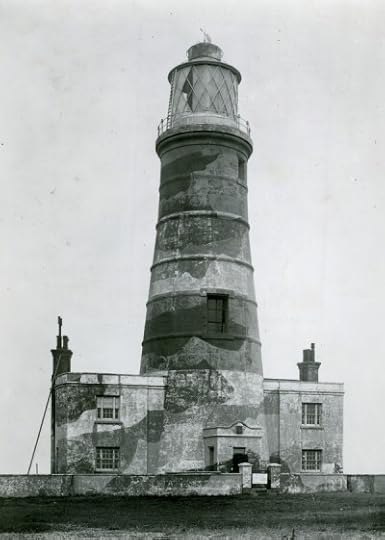
Orfordness Lighthouse in camouflage, UK, 1944
To commemorate the 80th anniversary of this historic day, Trinity House, the General Lighthouse Authority for England, Wales the Channel Islands and Gibraltar, has staged a series of events which culminate on this day.
Called “Lighting Their Legacy,” the flames of commemoration, the D-Day Torch, have been passed from veterans to young people, handling over the responsibility for the memories of World Wars to younger generations. These flames began in Canada and made their way across the United Kingdom to Trinity House and ending at Normandy on June 6.
Several UK lighthouses will join hundreds of other beacons of light as they participate in the event as well, including Cromer, Caldey, Lizard, Longstone, Lundy South, Peninnis, Start Point and Portland Bill lighthouses.
The light shines in the darkness, and the darkness has not overcome it. John 1:5 (NIV Bible)
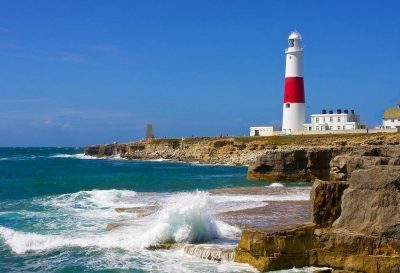
Portland Bill Lighthouse, UK
The post Lighthouses Commemorate D-Day appeared first on Pathways of the Heart.
April 8, 2024
The Lighthouse on Monkey Island
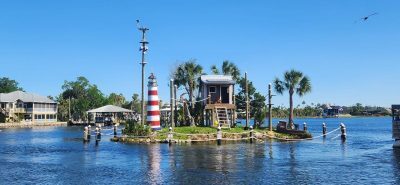
Monkey Island, 2024
Recently, I had the pleasure of “discovering” a very unusual lighthouse, the lighthouse on Monkey Island, Florida. This lighthouse isn’t located on an ocean or a huge lake. No, this lighthouse is on a tiny island in the Homosassa River.
So how did it get there and why, you ask. Well it started in the 1960’s, when a man named G. A. “Furgy” Furgason, one of the early developers of the Homosassa area, heard about a pile of rocks in the middle of the Homosassa River that was causing trouble. The rocks were submerged just enough to be unseen and near enough to the waterline to be a problem for boats. Furgy offered to help by having one of his dragline operators pile some dirt on the rocks so they could be seen better. When the operator got finished, he had created a small island about 60 feet in diameter. Furgy decided to add a small lighthouse on the island to help the boaters see the island and avoid it.
Meanwhile, Furgy was building an exotic plant and wildlife park in the area. Included in the attraction were some monkeys who had been brought to Amerca by a doctor who planned to use them to perfect the polio vaccine. However, these monkeys enjoyed their freedom a bit too much causing trouble for visitors to the park. In addition to escaping frequently, they stole candy, got into visitor cars and bit tourists. The monkeys needed a new home where they couldn’t cause trouble, so Furgy had them brought to the newly made island.
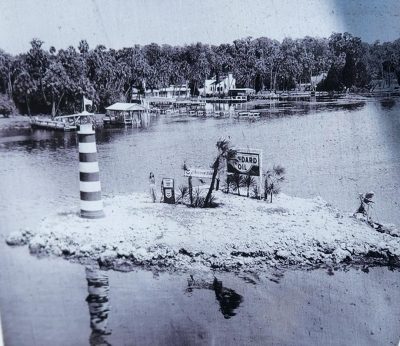
Original Monkey Island
On the island, they built the monkeys a hut and added a couple of palm trees. Over time, the island and the monkey’s habitat has been improved, and recently was completely renovated to give the monkeys a new hut, ropes to swing on and ladders to climb. The island is now covered in grass, which the monkeys enjoy rolling around on.
Now under the care of the Homosassa Riverside Resort, they are fed a healthy monkey diet of bananas, oranges, sweet potatoes, raw peanuts and monkey chow twice a day. They are also regularly examined by a primate veterinarian.
Thousands of people come to see Monkey Island each year, either on tour boats or from the local Monkey Bar. Because monkeys don’t like to swim, the river acts as a natural barrier while they enjoy the freedom of their island, playing, roaming, and watching all those crazy people come by to look at them.
And the lighthouse? It’s been painted a lovely red and white spiral and even has a solar-powered light to shine at night. No, it’s not an official aid to navigation, but it still serves the purpose of protecting boaters from running into danger.
What started out as an effort to help others became a blessing to Furgy and many others over the years.
“In the same way, let your light shine before others, that they may see your good deeds and glorify your Father in heaven.” Matthew 5:16
The post The Lighthouse on Monkey Island appeared first on Pathways of the Heart.
January 8, 2024
Saying Goodbye to the Lighthouse

Sally Snowman waves hello and goodbye.
When a new year comes around, many of us face changes in our lives.
Sally Snowman, the last remaining official lighthouse keeper in the US, retired the last day of 2023 from her post looking after the first lighthouse built in North America, on a tiny island in Boston Harbor. Snowman, who is 72, has been looking after Boston Light on Little Brewster Island for two decades. Her retirement was a result of the property being sold to a private owner. Since being designated a national landmark in 1964, the lighthouse has been staffed by government funding, making it the last staffed lighthouse in the country.
The lighthouse was built in 1716, almost a century after colonial settlers arrived from Europe, but had to be rebuilt after British forces blew it up in 1776 during the American Revolution
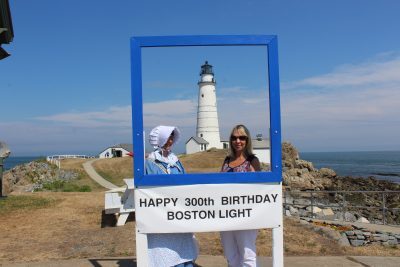
Sally and I celebrating the 300th birthday of the Boston Light.
In her role as lighthouse keeper, Sally Snowman has been known to wear history-appropriate 18th-century clothing while greeting visitors to her island outpost. Ever since Snowman’s father, a member of the Coast Guard auxiliary, took her to see the lighthouse when she was ten years old, she dreamed of being a lighthouse keeper herself.
Snowman had worked at the lighthouse for ten years as a volunteer before being hired as the keeper in 2003. She became Boston Light’s 70th caretaker, the first woman to hold the post. Now she’s the last person to do so. The beacon and its foghorn is still in service as a navigational aid though both have been fully automated since 1998.
She and her husband wrote three books about the lighthouse. Snowman said her favorite place to go was on the gallery at the top of the tower standing outside the lantern room to watch the everchanging views of the sea and sky.
During her time there, Snowman said that even with snow and sea pounding on the back of the keeper’s house and on every window, the experience was exciting. “If the house got washed off the island during the storm when I was asleep, what a way to go,” she said.”
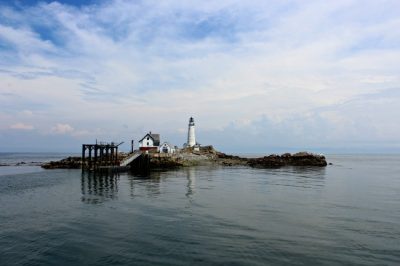
Little Brewster Island with Boston Lighthouse
Although confident the future owners will continue to care for the lighthouse property, Snowman had mixed feelings about leaving. Being a lighthouse keeper was a dream come true for her, but after 20 years, it was time to pass the baton, or should I say, light, over to the next caretaker.
Let your light shine this year. Matthew 5:16
The post Saying Goodbye to the Lighthouse appeared first on Pathways of the Heart.
December 24, 2023
Shine Your Light this Christmas
May your heart be filled with the love and joy of the one true light.
The post Shine Your Light this Christmas appeared first on Pathways of the Heart.
October 25, 2023
The Secret of its Strength
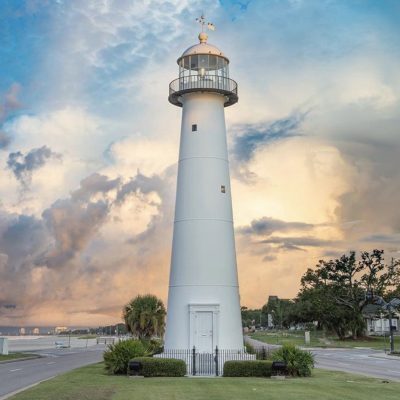
Biloxi Lighthouse, MS, photo by Alex North
If you travel on Highway 90 along the Gulf coast in Biloxi, Mississippi, you might be surprised to see a lighthouse in the median of the four-lane highway.
The Biloxi Lighthouse is unique for several reasons. One is its place in the median of a highway, the only lighthouse with such a location. Of course, it wasn’t always in that situation. Originally, a two-lane road passed by the lighthouse on the north side behind the keepers house. But after a storm destroyed the keepers house and removed some of the sand beneath the lighthouse causing it to lean, the land was reinforced and another two-lanes of road was added on the Gulf side, leaving the lighthouse in the middle.
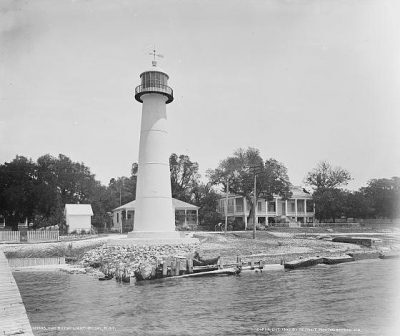
Biloxi Lighthouse, 1901, showing keepers house and oil house behind, Library of Congress photo
Another special feature of the lighthouse is its history of women lighthouse keepers. Although the first keeper was a man, in the next 92 years the lighthouse earned the distinction of being kept by female keepers for more years than any other lighthouse in the United States. In fact one of the keepers, Maria Younghans served for 51 years, retiring at age 77.
But why is the Biloxi lighthouse the only Mississippi lighthouse still standing of the original ten built to mark the Mississippi coastline? Despite being hit by several hurricanes, including two of the worst in Gulf Coast history, Camille in 1969 and Katrina in 2005, why has it remained? The answer is its core. Stephen Pleasonton, Fifth Auditor of the United States Treasury Department, announced he planned to put a cast iron lighthouse at Biloxi to prove its strength. Following a $12,000 appropriation by Congress on March 3, 1847 and competed in 1848, the Biloxi Lighthouse became the first cast-iron tower in the South.
And even though the storm surge of hurricanes managed to do some damage, with Camille reaching 17.5 feet on the tower and Katrina reaching 21.5 feet, the cast-iron tower survived.
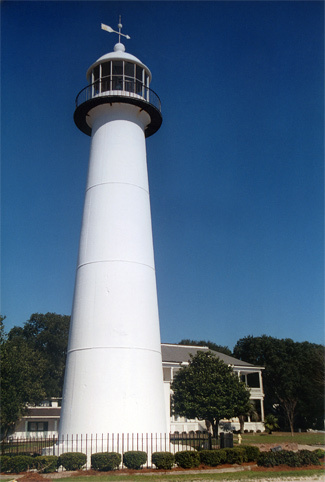
Biloxi Lighthouse, photo by Kraig Anderson
The importance of having a strong core can be applied to people as well. There are many times we encounter the storms of life and feel as though we might cave in, but our faith in God carries us through. That faith, belief and trust that God is our strength, is our core, and will keep us standing no matter what comes our way.
The Bible says in Isaiah 41, verse 10, “Fear not, for I am with you; be not dismayed, for I am your God; I will strengthen you, I will help you, I will uphold you with my righteous right hand.”
The post The Secret of its Strength appeared first on Pathways of the Heart.



